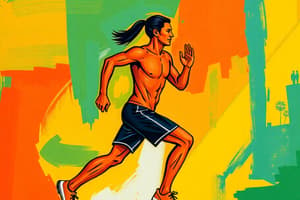Podcast
Questions and Answers
What effect does endurance exercise training have on mitochondrial density?
What effect does endurance exercise training have on mitochondrial density?
- Has no effect on mitochondrial density
- Increases the density of mitochondria (correct)
- Only affects muscle mitochondria in trained athletes
- Decreases the density of mitochondria
Which protein is primarily involved in the regulation of mitochondrial biogenesis?
Which protein is primarily involved in the regulation of mitochondrial biogenesis?
- LDH
- SDH
- PGC-1α (correct)
- ATPase
What physiological change occurs to lactate threshold as a result of aerobic training?
What physiological change occurs to lactate threshold as a result of aerobic training?
- It only affects untrained individuals
- It increases, requiring a higher workload for lactate accumulation (correct)
- It remains unchanged regardless of training
- It decreases, allowing for more lactate retention
Which of the following statements about mitochondrial adaptations to endurance training is false?
Which of the following statements about mitochondrial adaptations to endurance training is false?
Which method can be used to test changes in mitochondrial adaptations?
Which method can be used to test changes in mitochondrial adaptations?
What is primarily responsible for the increase in maximal endurance capacity during aerobic training?
What is primarily responsible for the increase in maximal endurance capacity during aerobic training?
Which adaptation is a result of increased capillarization from aerobic training?
Which adaptation is a result of increased capillarization from aerobic training?
How does aerobic training lead to increased mitochondrial numbers and size?
How does aerobic training lead to increased mitochondrial numbers and size?
What effect does aerobic training have on heart function?
What effect does aerobic training have on heart function?
Which fiber type shows a shift in percentage as a result of aerobic training?
Which fiber type shows a shift in percentage as a result of aerobic training?
What component is NOT typically enhanced through aerobic training?
What component is NOT typically enhanced through aerobic training?
Which term describes the muscle fibers' ability to adapt by changing protein expression due to exercise demands?
Which term describes the muscle fibers' ability to adapt by changing protein expression due to exercise demands?
Which physiological change occurs due to the increased blood flow from intense aerobic training?
Which physiological change occurs due to the increased blood flow from intense aerobic training?
What is the role of mRNA in the process of transcription?
What is the role of mRNA in the process of transcription?
Which equation correctly describes the relationship in the oxygen transport system?
Which equation correctly describes the relationship in the oxygen transport system?
Which of the following describes the effect of training on resting heart rate?
Which of the following describes the effect of training on resting heart rate?
What changes occur in stroke volume (SV) after training?
What changes occur in stroke volume (SV) after training?
How does training affect the sympathetic and parasympathetic activity in the heart?
How does training affect the sympathetic and parasympathetic activity in the heart?
Which factor contributes to the increase in stroke volume due to training?
Which factor contributes to the increase in stroke volume due to training?
What remains unchanged with training, despite changes in other cardiovascular adaptations?
What remains unchanged with training, despite changes in other cardiovascular adaptations?
Which statement describes the relationship between left ventricular mass and stroke volume after training?
Which statement describes the relationship between left ventricular mass and stroke volume after training?
Flashcards
Mitochondrial Density
Mitochondrial Density
The number of mitochondria per unit volume of muscle tissue. It increases with endurance training, leading to increased oxygen uptake (VO2) by muscles.
Mitochondrial Biogenesis
Mitochondrial Biogenesis
The process of creating new mitochondria within cells. This is stimulated during endurance training, leading to healthier and more efficient mitochondria.
PGC-1α
PGC-1α
A protein that regulates mitochondrial biogenesis. Increased levels of PGC-1α during endurance training signal for the creation of new mitochondria.
Lactate Threshold
Lactate Threshold
Signup and view all the flashcards
Aerobic Adaptations
Aerobic Adaptations
Signup and view all the flashcards
Transcription
Transcription
Signup and view all the flashcards
Translation
Translation
Signup and view all the flashcards
VO2max
VO2max
Signup and view all the flashcards
Fick Equation
Fick Equation
Signup and view all the flashcards
Cardiac Hypertrophy
Cardiac Hypertrophy
Signup and view all the flashcards
Stroke Volume (SV)
Stroke Volume (SV)
Signup and view all the flashcards
Preload
Preload
Signup and view all the flashcards
Afterload
Afterload
Signup and view all the flashcards
Cardiorespiratory Endurance
Cardiorespiratory Endurance
Signup and view all the flashcards
Endurance Training
Endurance Training
Signup and view all the flashcards
Increased VO2max
Increased VO2max
Signup and view all the flashcards
Capillarization
Capillarization
Signup and view all the flashcards
Myoplasticity
Myoplasticity
Signup and view all the flashcards
Muscle Fiber Adaptations
Muscle Fiber Adaptations
Signup and view all the flashcards
Overload Stimulus
Overload Stimulus
Signup and view all the flashcards
Capillary-to-Muscle Fiber Ratio
Capillary-to-Muscle Fiber Ratio
Signup and view all the flashcards
Study Notes
Adaptations to Aerobic Training
- Aerobic training improves cardiorespiratory endurance, the ability to sustain prolonged dynamic exercise.
- Improvements occur through multi-system adaptations including cardiovascular, respiratory, muscle, and metabolic systems.
- Endurance training elevates maximal endurance capacity (VO2 max).
- Submaximal endurance capacity also increases, meaning a lower heart rate at the same submaximal exercise intensity.
- This is more closely linked to competitive endurance performance.
- The Fick Equation is important to remember.
Aerobic Adaptations
- VO2 max increases due to enhanced oxygen-carrying capacity (hemoglobin and myoglobin), plasma volume, capillarization, mitochondrial number and size, and mitochondrial enzymes.
- Fiber diameter decreases and heart function (Q & SV) increases.
- More oxidative fibers (Type IIa) increase.
Overload Example
- Arteries and veins run parallel to muscle fibers forming a network around them.
- Overload stimulates increased capillarization.
- Vascular stretch and shear stress from increased blood flow during exercise develop more capillaries, improving training effectiveness.
- Trained muscle has a higher capillary-to-muscle fiber ratio.
- Enhanced microcirculation improves removal of heat and metabolic byproducts from active tissues, alongside oxygen, nutrient, and hormone delivery.
Muscular Adaptations
- Myoplasticity determines the ability of muscle fibers' genetic machinery to change the quantity or quality of protein expression.
- Adaptations depend on the demands placed on the muscle.
- Transcription involves the expression of target genes in DNA to create mRNA.
- Translation utilizes ribosomes to translate mRNA, attaching amino acids to create proteins.
Cardiovascular Adaptations
- O2 transport system and Fick equation are crucial.
- VO2 max increases due to increased max SV x max HR x max (a-v)O2 difference.
- Heart size and LV volume increase with training (cardiac hypertrophy).
- Plasma volume increases with training leading to higher EDV and SV.
- SV increases due to the volume loading effect / Frank-Starling Law, and increased force of contraction with training.
Cardiovascular Adaptations (Continued)
- Resting heart rate (HR) decreases markedly with training (~1 beat/min per week). This reduced HR is due to increased parasympathetic nervous system influence and decreased sympathetic nervous system influence on the heart.
- Submaximal HR remains the same for the same absolute intensity of exercise.
- Training provides greater reductions in submaximal HR at higher submaximal intensities.
- Maximum HR does not change with training.
- Faster recovery HR also occurs and can be used to predict VO2max.
Mitochondrial Adaptations
- Mitochondrial density increases leading to increased (a-v)O2max.
- Endurance training improves the quality of muscle mitochondria through biogenesis (production of new, healthy mitochondria) and reduces the degradation of mitochondria.
- PGC-1a regulates these changes.
- Testing involves measuring PGC-1a and other mitochondrial enzymes.
Lactate Threshold
- Lactate threshold rises in response to aerobic training.
- Aerobic systems adapt to work more efficiently and produce ATP at a faster rate to handle increasing demands.
- Training allows the body to delay the accumulation of lactate at a higher workload.
Bioenergetic Adaptations
- Aerobic enzymes and oxidative potential of fast-twitch (FT) fibers increase.
- Glycogen, VO2 max, and cross-section size of slow-twitch (ST) fibers also increase with training.
- Capillaries increase in response to training leading to more efficient oxygen delivery.
Studying That Suits You
Use AI to generate personalized quizzes and flashcards to suit your learning preferences.




